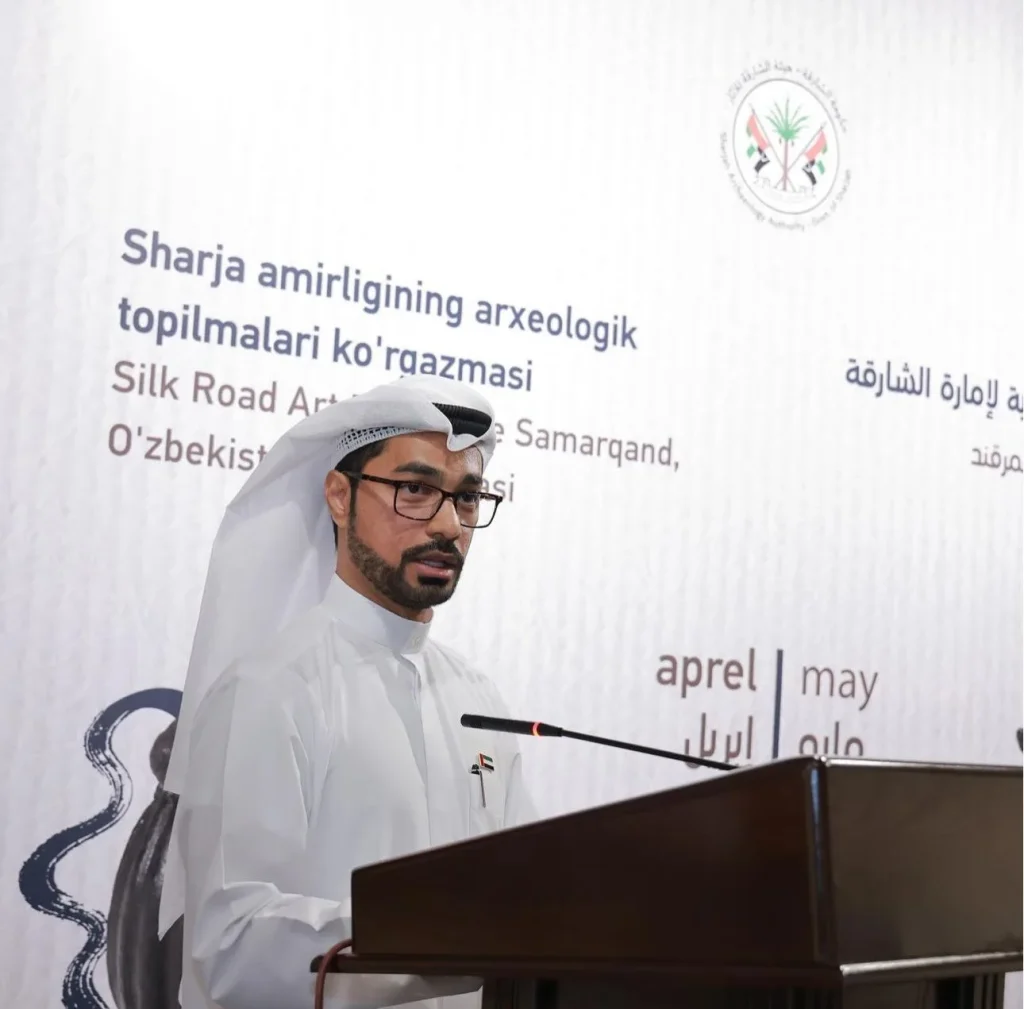Date Of Exhibitions
07 - 2025
Running from April 18 to May 22, 2024
Sharjah Archaeology Authority opens the exhibition “From Arabia to Central Asia: treasures from Sharjah at the Silk Road” in Uzbekistan
The Sharjah Archaeology Authority (SAA) inaugurated today, Thursday, the exhibition “From Arabia to Central Asia: treasures from Sharjah at the Silk Road” at the Silk Road Art House in Samarkand, in collaboration with the Ministry of Ecology, Environmental Protection and Climate Change of the Republic of Uzbekistan. The event was attended by Sheikh Fahim Al Qasimi, Chairman of the Department of Government Relations (DGR) in Sharjah, along with an official delegation from the Sharjah government, represented by a number of officials and representatives of the relevant authorities and entities concerned with cultural heritage in the Emirate of Sharjah.
Exploring More Than 120 Artefacts
The exhibition, which runs from April 18 to May 22, 2024, tells the story of the history and cultural heritage and the relationship between the Arabian Peninsula and Central Asia. It is based on archaeological materials discovered in the Emirate of Sharjah from the Neolithic age to the Islamic period. It also explores over 120 distinctive artefacts that highlight the cultural and archaeological heritage of Sharjah, bridging the past and the present across three main galleries. Among the most significant items is “The Dirham” which dates back to the Caliph Harun al-Rashid and was minted in Samarkand in the year 182 AH, known to be the rarest Dirham discovered to date.
Highlighting the Scientific Aspect
The organization of the exhibition continues the Sharjah Archaeology Authority’s program of archaeological exhibitions at both the local and international levels, underlining the SAA’s commitment to highlighting the scientific aspect that enhances the studies and research conducted at archaeological excavation sites. This effort aims to establish deep-rooted and significant cultural and tourism bridges that connect the past, present, and future and to exchange expertise to affirm the presence of the Emirate of Sharjah at various regional and international events.
The United Arab Emirates in general, and the Emirate of Sharjah in particular, are rich in a significant legacy of important archaeological sites that encapsulate the history and civilization of the state from ancient times. This reflects the civilizational exchange between the civilizations that have passed through it over many centuries. Additionally, showcasing archaeological artifacts that illustrate Sharjah’s relationships, its role, and its importance in the global trade routes throughout history is crucial for developing archaeological awareness among different community segments at both the local and global levels.
Cultural Communication
The exhibition gives visitors the chance to learn about the story of communication along the Silk Road and the significance of Samarkand as a historical city. Additionally, the archaeological discoveries at the Mleiha site such as the palace, fortifications, houses, and human and animal burials, and the discovery of two harbors (Dibba and Ed-Dur) linking it to the Gulf and Oman Sea are showcased. The archaeological findings consist of rare artifacts, including those decorated and made from gold, silver, bronze, iron, ivory, carnelian soft stone, alabaster, and glass. These unique discoveries demonstrate the interaction between civilizations such as the Egyptian, Greek, Roman, Parthian, Central Asian, and Indian cultures.
Exhibition Halls
The first hall of the exhibition includes the beginnings of human arrival in the Emirate of Sharjah, highlighting the Stone Age period in Sharjah, starting with the oldest of these periods dating back to 500,000 years, known as the Acheulean period, followed by the Middle Paleolithic period and the New Stone Ages.
The second hall of the exhibition contains a number of archaeological findings from the Bronze and Iron Ages, including discoveries from the sites of Jebel Al Buhais, Tell Abraq, Muwaileh, Al Thiqaiba, and Mleiha. These are represented by a range of distinctive archaeological exhibits from the pre-Islam era, such as a collection of pottery jars and copper vessels, bronze statues, and a gravestone inscribed in both Musnad and Aramaic scripts, as well as a collection of coins discovered in the Emirate of Sharjah.
The exhibition concludes with a hall dedicated to the Islamic period, highlighting the region’s role during that era. The findings from this period include Abbasid jars, incense burners, pottery plates, and Abbasid dirhams. The sites covered include the city of Sharjah, Tuwaileh, Luluya, Khor Fakkan, Dibba Al-Hisn, and Al-Dhaid.









